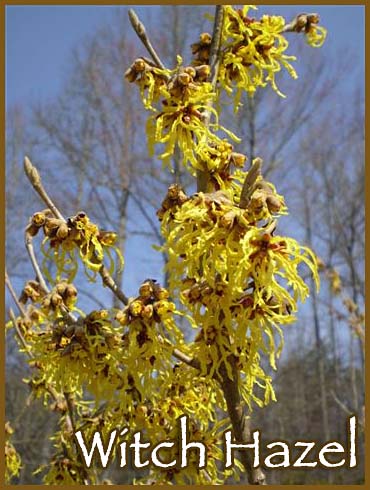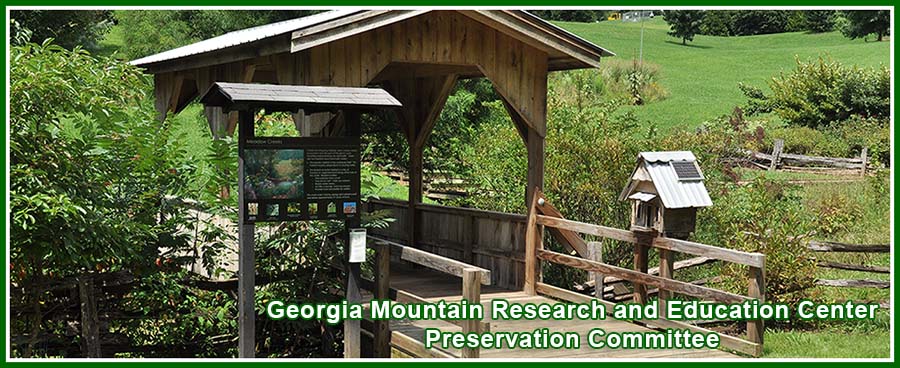Witch Hazel; A Winter Blooming Native Tree
By Jennifer Cordier, Preservation Committee Member
 Long before I became interested in native medicinal plants, I was familiar with witch hazel. My mother kept a bottle of witch hazel liniment in her first aid kit and rubbed it on my childhood scrapes and bruises. I thought the clear liquid had an interesting name, but I knew little of its source. Years later, after moving to the North Georgia Mountains, I discovered the witch hazel tree and I became enchanted by its strange winter blooming flowers, its distinctive citrus-like aroma and its incredible healing powers.
Long before I became interested in native medicinal plants, I was familiar with witch hazel. My mother kept a bottle of witch hazel liniment in her first aid kit and rubbed it on my childhood scrapes and bruises. I thought the clear liquid had an interesting name, but I knew little of its source. Years later, after moving to the North Georgia Mountains, I discovered the witch hazel tree and I became enchanted by its strange winter blooming flowers, its distinctive citrus-like aroma and its incredible healing powers.
My discovery took place in early winter on a hike to the top of Blood Mountain. It was one of those perfect winter days when you dress in layers and then begin shedding jackets as the sun pours down from a bright blue sky. Half way up the trail I was suddenly surrounded by a heavenly aroma. It was clean and sharp, reminding me of fresh citrus. I looked for the source and there, scattered along the trail and through the woods, were witch hazel trees in bloom. The trees were small, about ten to twelve feet tall, and, if not for their heavenly aroma, I may have passed them by without notice. How fortunate that we have five senses with which to discover our world!
On another occasion, while hiking the trails around Lake Winfield Scott on a balmy October afternoon, I happened upon a much larger witch hazel tree. It stood about twenty feet tall and its bare branches were covered with delicate small yellow flowers, each with four narrow petals that resembled thin shreds of crepe paper. This was obviously an older tree that had thrived at the edge of the forest in an open sunny area.
Witch hazel, Hamamelis virginiana, has powerful healing properties and was a favorite of the American Indians to treat wounds, sore muscles, insect bites, dysentery and colds and coughs. Distilled witch hazel, made from the leaves and bark, has been a staple in North American medicine chests for several hundred years. While most herbs are sold as dietary supplements, witch hazel is one of very few American medicinal plants still approved as an ingredient in non-prescription drugs by the FDA. Witch hazel is approved as an over-the-counter astringent in the external analgesic (pain- relieving), skin protectant categories, and as an external anorectal, primarily used to relieve hemorrhoids. In Germany, the bark and leaf are approved for treatment of mild diarrhea, inflammation of the gums and mucous membranes of the mouth, and mild irritation or local inflammation of the skin, hemorrhoids and varicose veins.
This fascinating tree adds seasonal interest to the home landscape. A popular cultivar is Arnold Promise Witch Hazel, Hamamelis x intermedia. I have added it to my landscape, planting it in an area that gets full sun and good moisture. Being a cultivar, Arnold Promise blooms a bit later than Hamamelis virginiana. In late winter, about the time when I am sowing flats of seeds in my greenhouse, I am rewarded with that marvelous citrus-like aroma coming from the bright yellow “crepe paper” flowers which cover the bare branches of my witch hazel tree.
The Preservation Committee of the Community Council of UGA’s Mountain Research and Education Center serves to educate the public about the importance of preserving the treasure trove of native plants that are found in our southern Appalachian mountains. For more information about the work of the Preservation Committee as well as volunteer opportunities, please visit our website; www.gmrec.uga.edu or call the Georgia Mountain Research and Education Center ( 706-745-2655 ) and speak with Clare Johnston.
of C. Wayne Dukes and Sherry Bell Dukes. 1996 - 2017, except where otherwise stated. All rights reserved, reproduction,
downloading, and/or duplication of any sort is strictly prohibited, all violations will be prosecuted. Legal Policy.
If you have any questions, or comments, regarding this site, e-mail the Highlander.


